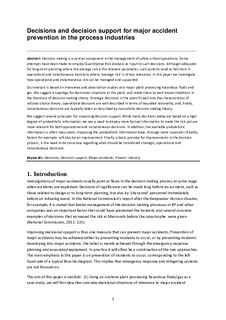| dc.contributor.author | Kongsvik, Trond | |
| dc.contributor.author | Almklov, Petter | |
| dc.contributor.author | Haavik, Torgeir K | |
| dc.contributor.author | Haugen, Stein | |
| dc.contributor.author | Vinnem, Jan Erik | |
| dc.contributor.author | Schiefloe, Per Morten | |
| dc.date.accessioned | 2017-10-24T07:07:18Z | |
| dc.date.available | 2017-10-24T07:07:18Z | |
| dc.date.created | 2015-04-21T16:33:02Z | |
| dc.date.issued | 2015 | |
| dc.identifier.citation | Journal of Loss Prevention in the Process Industries. 2015, 35 85-94. | nb_NO |
| dc.identifier.issn | 0950-4230 | |
| dc.identifier.uri | http://hdl.handle.net/11250/2461561 | |
| dc.description.abstract | Decision making is a central component in the management of safety-critical operations. Some attempts have been made to employ Quantitative Risk Analysis as input to such decisions. Although adequate for long-term planning where the average risk is the relevant parameter, such systems tend to fall short in operational and instantaneous decisions where ‘average risk’ is of less relevance. In this paper we investigate how operational and instantaneous risk can be managed and supported.
Our analysis is based on interviews and observation studies at a major plant processing hazardous fluids and gas. We suggest a typology for decisional situations at the plant, and relate these to well-known traditions in the literature of decision-making theory. Strategic decisions in the plant fit well into the characteristics of rational choice theory, operational decisions are well described in terms of bounded rationality, and, finally, instantaneous decisions are typically taken as described by naturalistic decision making theory.
We suggest several principles for improving decision support. While many decisions today are based on a high degree of probabilistic information, we see a need to deploy more factual information to make the risk picture more relevant for both operational and instantaneous decisions. In addition, the available probabilistic information is often inaccurate; improving the probabilistic information base, through more nuanced criticality factors for example, will also be an improvement. Finally, a basic premise for improvements in the decision process, is the need to be conscious regarding what should be considered strategic, operational and instantaneous decisions. | nb_NO |
| dc.language.iso | eng | nb_NO |
| dc.publisher | Elsevier | nb_NO |
| dc.title | Decisions and decision support for major accident prevention in the process industries | nb_NO |
| dc.type | Journal article | nb_NO |
| dc.description.version | submittedVersion | nb_NO |
| dc.source.pagenumber | 85-94 | nb_NO |
| dc.source.volume | 35 | nb_NO |
| dc.source.journal | Journal of Loss Prevention in the Process Industries | nb_NO |
| dc.identifier.doi | 10.1016/j.jlp.2015.03.018 | |
| dc.identifier.cristin | 1238352 | |
| dc.relation.project | Norges forskningsråd: 228237 | nb_NO |
| dc.description.localcode | This is a submitted manuscript of an article published by Elsevier Ltd in Journal of Loss Prevention in the Process Industries, 26 March 2015 | nb_NO |
| cristin.unitcode | 194,64,20,0 | |
| cristin.unitname | Institutt for marin teknikk | |
| cristin.ispublished | true | |
| cristin.fulltext | original | |
| cristin.fulltext | preprint | |
| cristin.qualitycode | 1 | |
